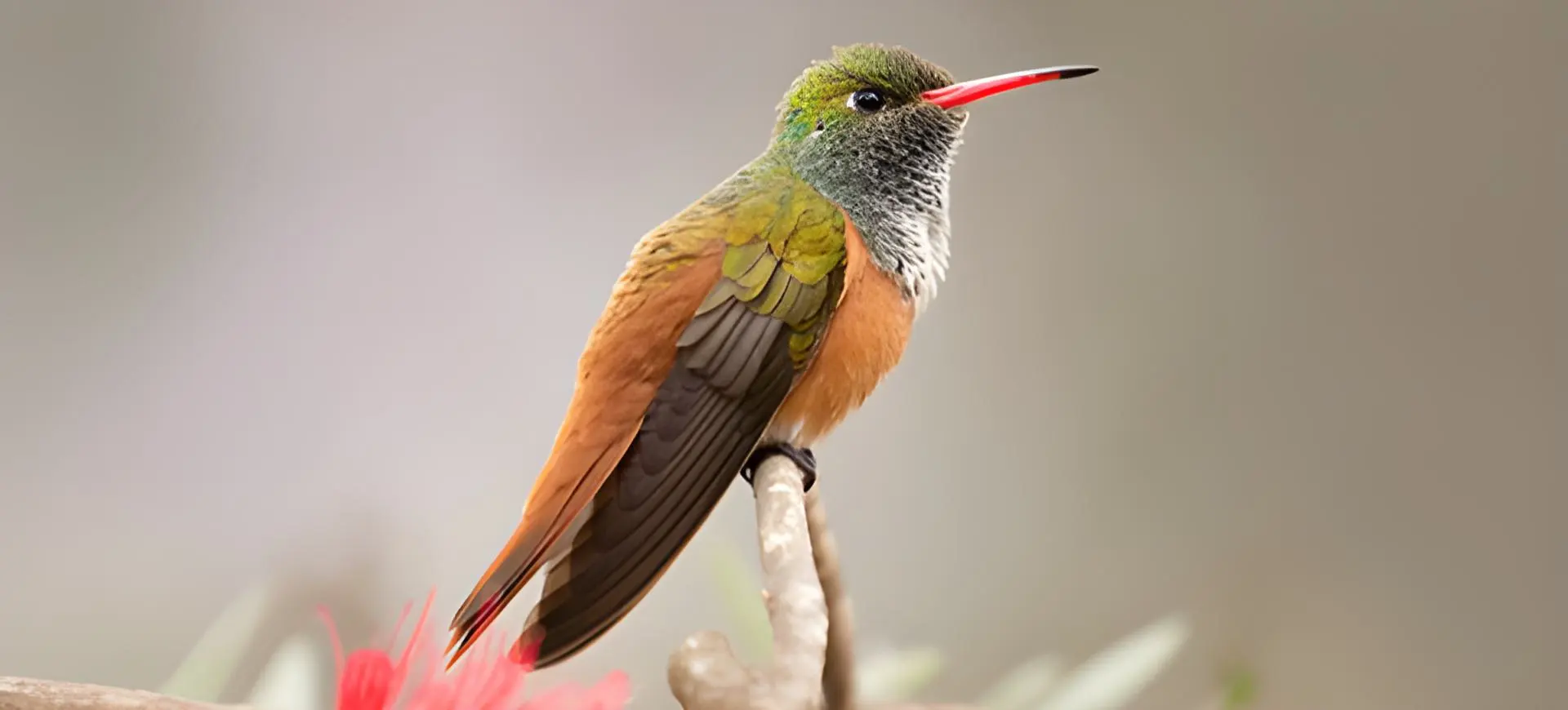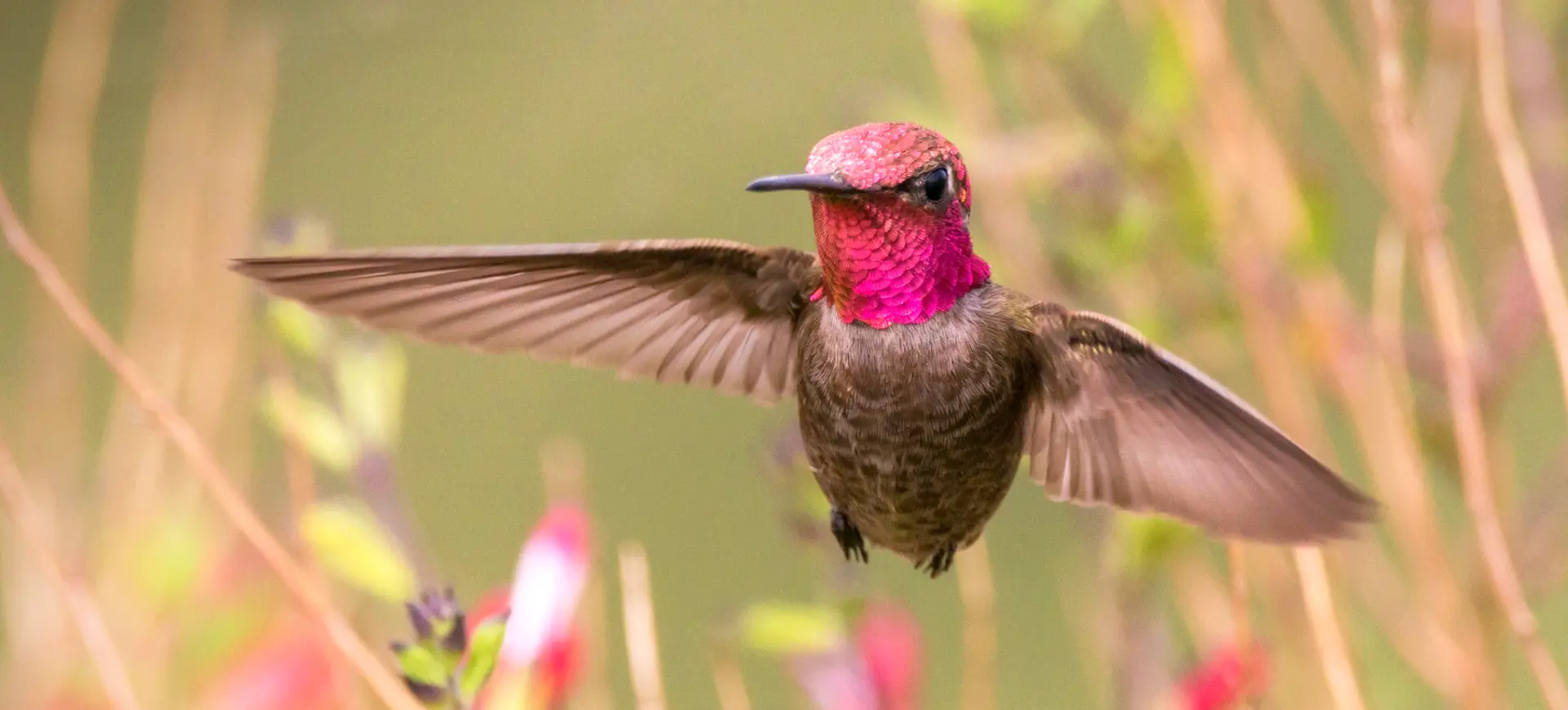Overview
The Broad-billed Hummingbird (Cynanthus latirostris) is a small, vibrant bird known for its striking coloration and remarkable flying abilities. Native to the North American regions, particularly the southwestern United States and Mexico, this species is easily recognized by its bright blue throat and green body in males. At the same time, females exhibit a more subdued green and white coloration. The bird’s most distinctive feature is its broad, red bill with a black tip, which is well adapted for feeding on nectar from various flowers.
The Broad-billed Hummingbird is an active and agile flier, capable of hovering in mid-air, flying backward, and even upside down. This agility is crucial for accessing nectar deep within flowers. Despite its small size, this hummingbird is territorial and often seen chasing away intruders from its feeding areas. It’s also known for its rapid, darting flight and ability to cover long distances during migration.
Like other hummingbirds, the Broad-billed Hummingbird plays a vital role in pollination. As it feeds on nectar, pollen sticks to its head and is transferred from flower to flower. This bird is a marvel of nature due to its flying prowess and energetic lifestyle, requiring it to consume half its body weight in food daily to support its high metabolism.
Taxonomy
Kingdom
Phylum
Class
Order
Family
Genus
Species
Sub Species
Type
Physical Description:
The Broad-billed Hummingbird is small, typically measuring about 3.5 inches long and weighing around 3-4 grams. Males are particularly striking, with iridescent blue throats and bright green backs and heads. Their underparts are mostly grey-white, starkly contrasting the vibrant upper body. The namesake broad bill is bright red with a black tip, making it one of the most distinctive features of this species.
Females, while not as brightly colored as males, have their subtle beauty. They exhibit a more muted green on their upper parts and a white belly with dark streaks. Both sexes have long, narrow wings that beat so fast they are often just a blur, supporting their acrobatic flying maneuvers. The tail is typically dark in color and forked, aiding in quick turns and stops mid-air.

Lifespan: Wild: ~3 Years || Captivity: ~5 Years

Weight: Male & Female: 0.1-0.14 oz (3-4 g)

Length: Male & Female: 3.1-3.5 inches (8-9 cm)

Wingspan: Male & Female: 4.3-4.7 inches (11-12 cm)

Top Speed: 30 mph (48 km/h)
Characteristic:
Native Habitat:
Broad-billed Hummingbirds are native to various habitats, ranging from arid deserts and scrublands to oak woodlands and pine-oak forests. They are commonly found at elevations from sea level up to 6,000 feet but can occasionally be higher, especially in Mexico. These birds prefer areas rich in flowers, which provide the necessary nectar for their high-energy lifestyle.
Their habitat selection is closely tied to food availability, and they can often be found in areas where flowering plants are abundant. During the breeding season, they may also seek out territories that offer suitable nesting sites, such as in the branches of trees or shrubs.
Biomes:
Biogeographical Realms:
Continents:
Countries:
Diet:
Diet & Feeding Habits:
Broad-billed Hummingbirds are primarily nectarivores, feeding on the nectar from various brightly colored, tubular flowers. They prefer red and orange flowers but will not limit themselves if other sources are available. Their long, specialized bill allows them to reach deep into flowers to access nectar, while their rapid wing beats enable them to hover in place as they feed.
In addition to nectar, these birds consume small insects and spiders, providing them with necessary protein and other nutrients not found in nectar. They are important pollinators in their ecosystems, as their feeding behavior results in the transfer of pollen from one flower to another.
Mating Behavior:
Mating Description:
Broad-billed Hummingbirds have a polygynous mating system where males mate with multiple females but do not participate in raising the offspring. During breeding, males establish territories rich in food resources and perform aerial displays to attract females. These displays include a series of dives and arcs, showcasing their agility and bright colors.
Females are solely responsible for nest-building, incubation, and chick-rearing. They construct small, cup-shaped nests from plants down and spider webs, holding two white, pea-sized eggs. The female incubates the eggs for about two weeks and continues to feed and care for the chicks for another 20-24 days until they fledge.
Reproduction Season:
Birth Type:
Pregnancy Duration:
Female Name:
Male Name:
Baby Name:
Social Structure Description:
Broad-billed Hummingbirds are generally solitary birds, especially outside of the breeding season. They are territorial and can be quite aggressive in defending their feeding areas from other hummingbirds. Males establish and defend territories that contain good food sources, and females are solely responsible for nest-building and chick-rearing.
Despite their solitary nature, they may be seen in areas with abundant food sources, such as flowering trees or well-maintained hummingbird feeders, where multiple individuals take advantage of the resources despite frequent aggressive interactions.
Groups:
Conservation Status:
Population Trend:
Broad-billed Hummingbirds are considered widespread within their range. While exact population numbers are unknown, they are not considered at risk. However, like many other species, they could be affected by habitat loss and climate changes, which may impact the availability of their floral food sources.
They are adaptable birds, exploiting a range of habitats and food sources. This adaptability, along with their high reproductive potential, helps to buffer against population declines. However, ongoing monitoring is necessary to ensure that populations remain healthy.
Population Threats:
The primary threats to Broad-billed Hummingbirds include habitat loss and degradation, particularly from urban development and agricultural expansion. Pesticide use can reduce insect food sources and harm the birds if they ingest contaminated nectar. Climate change may also impact their habitat and the timing and availability of their floral food sources.
As migratory birds, they are also at risk during their travels, facing threats such as window collisions and predation. Despite these challenges, they are currently not considered high risk, but continued conservation efforts are important to ensure their success.
Conservation Efforts:
Conservation efforts for Broad-billed Hummingbirds primarily focus on habitat preservation and restoration. Protecting areas rich in flowering plants and ensuring a variety of nectar sources are available year-round is crucial. Creating and maintaining hummingbird-friendly spaces can provide crucial resources for these and other hummingbird species, even in urban and suburban areas.
Education and awareness programs can help reduce threats from pesticide use and window collisions. Additionally, research and monitoring efforts are important for understanding their ecology, migration patterns, and population trends to inform future conservation strategies.
Additional Resources:
Fun Facts
- The Broad-billed Hummingbird’s bill is broad and slightly curved, perfect for accessing nectar from various flowers.
- Despite their small size, they are long-distance migrants, with some traveling from the southwestern U.S. to Mexico and Central America for the winter.
- They can beat their wings up to 80 times per second, creating the humming sound that gives them their name.
- Broad-billed Hummingbirds can enter a state of torpor at night to conserve energy, significantly reducing their metabolic rate.
- They are one of the few bird species that can fly backward.
- Their bright colors are not the result of pigment but rather the refraction of light through their feather structure.
- These birds have excellent memory and can remember every flower they’ve visited and how long it will take each flower to refill with nectar.
- Unlike most birds, they have very little or no sense of smell.
- Broad-billed Hummingbirds’ hearts can beat up to 1,260 times per minute.
- They are one of over 300 species of hummingbirds, all found in the Americas.











